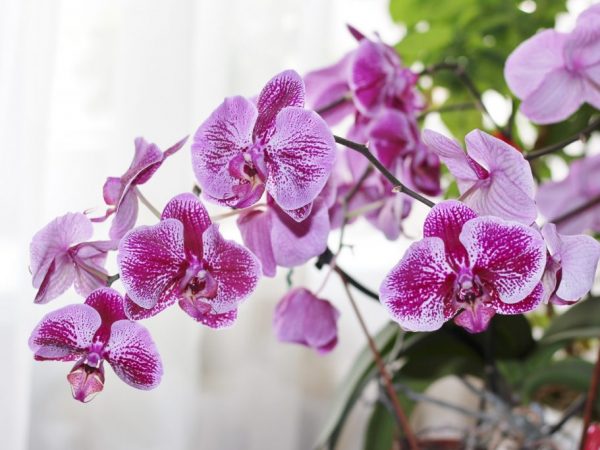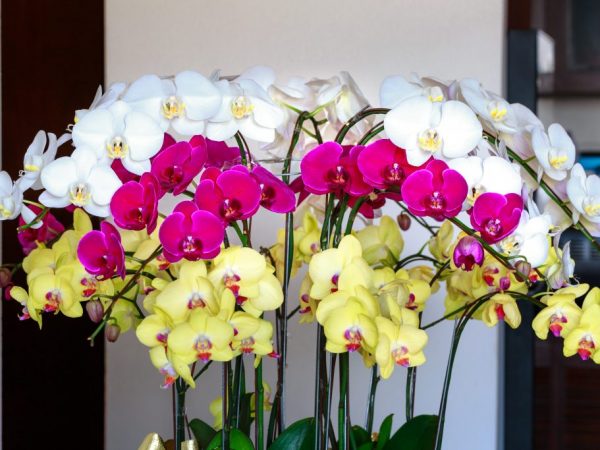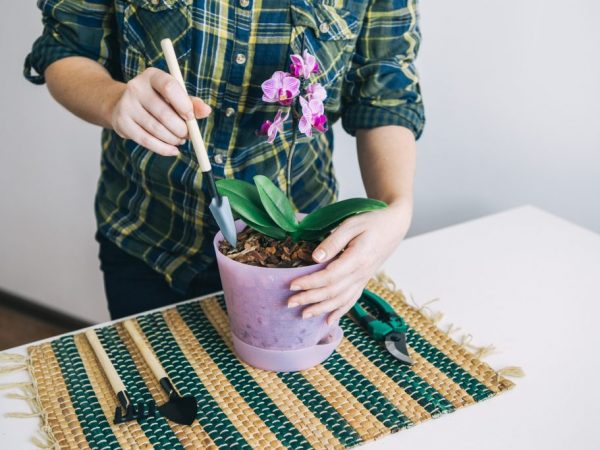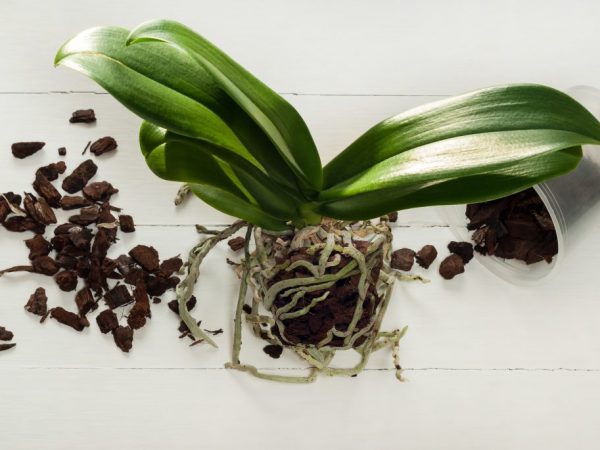Description of the Phalaenopsis orchid
Phalaenopsis Orchid is a perennial plant popular for its long flowering time. It has bright petals and many varieties. It is undemanding to care for, so it is a good option for novice florists. But with its reproduction, difficulties often arise.

Description of the Phalaenopsis orchid
Description of the variety
In the wild, Phalaenopsis orchids live in moist warm forests. They originated in Asia and have about 70 species. According to the description, the structure of orchids consists of tuberidia or pseudobulbs, but Phalaenopsis lacks this.
It is a monopodial orchid that grows slowly in height. Orchids are cultivated with a bulb. The amount of vital energy of a flower depends on how many years an orchid lives, but it decreases when stimulating flowering and development of children. During the breeding season of Phalaenopsis, fertilizers and feeding should be applied.
Phalaenopsis is not inferior in the frequency of keeping the house to the Dendrobium Nobile hybrid.
Description of leaves and tree
Phalaenopsis is an orchid with a special rhythm of development, growth and smell. To determine the age of a plant, count the number of large leaves.
An adult tree is rosette-shaped with two rows of leaves.
The Phalaenopsis home orchid has a short stem that grows upward. And the system of aerial roots is well developed. Their thickness is up to 7 mm in diameter. The roots are covered with a layer of a special absorbent fabric - velamen. They have a silvery green color.
Phalaenopsis at home reaches 50-70 cm. In a healthy plant, the rosette consists of 4-6 leaves. Up to 2 new leaves appear during the year. They are dense, colored deep dark green. They have an oblong-oval shape. They are located alternately, and a peduncle grows between them.
Description of colors
Peduncles, depending on the species, are long (up to 80 cm) and short (about 20 cm). Are curved or straight. Flowers also have different diameters from 2 to 15 cm. They are collected in racemose inflorescences and resemble the shape of a butterfly or a star. The growth period varies from 2 months to six months.
The Phalaenopsis orchid has a pleasant and unobtrusive aroma.
The Phalaenopsis home orchid blooms twice a year - in spring and autumn. The flowering period depends on the interaction of the general condition of the plant and the characteristics of care.
Types of varieties
Phalaenopsis flower is distinguished by the size of the leaves, the length of the peduncle and the color. Characteristics of the varieties:
| Variety name | Description |
| Amabilis | Leaves from 30 to 50 cm, green, up to 12 cm in diameter. The petals are white and the flower lip is yellow or peachy. Amabilis bloom from early autumn to March. |
| Schiller (Schilleriana) | Flowers are lilac or single color. Blooms in winter. |
| Stuart (Stuartiana) | Peduncles are long - 80 cm in length. Pedigree petals with red spots at the base. Bloom from mid-winter to March. |
| Amsterdam Jordan | Crimson petals in a dark point. The lip has a burgundy tint. |
| Horse (Equestris) | Pleasant aroma and large leaves up to 13 cm. Flowers purple or lilac. |
| Natasha (Natasha Aiko) | It has 3 pairs of leaves and grows up to 12 cm. Pink or green with spots all over the flower. |
Variegated Phalaenopsis variegated includes varieties: Philippinensis and Lindeni. The species Stone Rose, Little Zebra, Sumatra, Ping, Rossini and Sacramento are famous for their raspberry shades, and the small-flowered variety Phoenix, Venus, Fialkovy, Tonka and Pulkhra are famous for their rich smell.

The Phalaenopsis orchid has many varieties
Yellow petals: Solid Gold, Nina Queen, Yara, Mango and Maya with red splashes. The trumpet mushroom is colored orange, like Surfsong and Novelty.
Varieties with white petals:
- Leopard Prince;
- York;
- Pinlong;
- Ikaria;
- Leonardo;
- Cambridge;
- Phalaenopsis super beauty.
- Tetraspis and Gemeng - white petals with red dots.
The purple color is typical for Phantom and Extra, Multi, Martin, Angel, Rider, Cherry and Jewel varieties. The Mann species has green leaves with purple dots.
The Mandala variety has a creamy caramel petal color with a Leopard lip. Sesame features a tiger pink and white pattern on the petals. Interesting flowering species: Panda, Elegant, Deborah, Aloha, Leo, Ravello, Zion and Tabor.
Orchid facts say there is a Royal species among its varieties. Plants are blue in color and look like the sky. But in natural living conditions, there is no such color.
Growing
A pot with a plant is recommended to be placed in the northwestern part of the apartment or in the east with shading. For this, placement on a windowsill or balcony is suitable. The orchid does not like to change its place of residence, so the florist does not move it from one place to another in order to grow a healthy flowerpot.
Small pots are used to grow the plant. At their bottom, there must be drainage holes, and their height is equal to the width of the neck. The most common option is plastic pots, which prevent the root system from drying out. With the help of plastic flowerpots you can clearly see:
- root growth;
- moisture consumption over the substrate;
- when the soil is completely dry.
They also use clay flowerpots, preheated and moistened. Orchids are also grown in a greenhouse, hydrogel or hydroponically, like houseplants. Hydroponics is when flowers grow in water, expanded clay in glass containers.
Phalaenopsis hybrid is a monopodial orchid. A single growth point appears at the top of the shoot. Therefore, they reproduce by children, seeds or cuttings, they rarely use tree division.
Pollination
For Phalaenopsis, only cross-pollination is characteristic. Autogamy in a flower is almost impossible. If several plants are grown at home that bloom at the same time, then hybrid pollination is carried out.
Several plants are recommended to pollinate at the same time. This increases the chance of getting seeds. With a successful pollination of even one specimen, untouched flowers will not bloom for a long time.

It is better to pollinate several plants at the same time
Flower seeds ripen from 6 to 8 months.
Growing seeds at home: There is a column at the end of the flower, which is torn off gently with tweezers. Polylines are removed from it and placed in another flower. To fix the polylines, they are placed on sticky walls. If the bud is successfully pollinated, the plant's sinus will close. After which it dries up, and the stem swells. When the flower turns brown, they start sowing.
Reproduction by children
Propagated by children 2 months after the end of flowering (at the end of February or mid-June).
Choose an adult plant over 2 years old, with 4 large leaves. For the process you will need:
- crushed activated carbon;
- blade or knife;
- pine bark, sphagnum and perlite soil;
- container with drainage holes.
To begin with, the children are cut off from the stem of the peduncle with a sharp object, and they are given time to dry. We process the cut sites with activated carbon.After the shoot is planted in a container with a substrate and watered along the edge. Keep the sprout at a temperature of 30 ° C during the day, 15 ° C in the evening.
If a baby sprout does not appear on the peduncle, then measures are taken to stimulate the plants. To wake up the kidneys, the scales are carefully removed without injuring the dormant kidneys. After that, a little hormonal paste is applied to them, or wet moss is placed over the kidneys and covered with polyethylene. The content of the hormonal mixture includes:
- 10 g kinetin;
- 1 ml of water;
- 1 g lanolin.
The mixture should turn white. Children are also treated with hormonal drugs:
- "Heteroauxin";
- Kornevin;
- Epin.
Propagation by cuttings
When propagating, you should carefully handle the roots. Only a healthy Phalaenopsis orchid is successfully propagated. The propagation method by cuttings is more complex. It is done after the plant has faded.
For cuttings, side shoots 10-15 cm in length are used. They need to be separated, and the upper shoot is cut off with a sharp, sterile object. The sections are treated with charcoal. After the sprout is placed in a container with a substrate.
Wet sphagnum and a small amount of moss are chosen as the soil. Temperature 25-28 ° C.
Care

Good care will prolong the life of the plant
In order to give Phalaenopsis appropriate care and prolong its life, several agrotechnical measures are taken.
| Agrotechnical event | Application |
| Watering | Pour from a watering can along the edges of the pot or by immersing the flowerpot in a container of water. During the flowering period, watering is recommended from a watering can. And immerse the pot in a container of water for 30 minutes. Watering the plant abundantly is not recommended. Watering is carried out in small doses every 12 days, before lunch. Variegated Phalaenopsis can withstand up to 2 weeks without watering. Water is used 2-3 ° C above room temperature. It should be free of lime, salt and chlorine. If the roots of the plant turn brown, it means overflow. Also determine the dryness of the soil with your hands, placing your fingers a little deep into the ground. |
| Temperature regime | The optimum temperature is from 10 to 28 ° C. At a temperature of 30 ° C, the flowerpot is provided with good air circulation. |
| Lighting | During the day, the plant is provided with 12 hours of light. In late spring and summer, the flower is protected from direct sunlight. For artificial light, choose a phytolamp or a fluorescent lamp. |
| The soil | An orchid is planted in a large pine bark. A granite stone is placed at the bottom of the container, and I tweak the foam under the base of the flower. Sprinkle on top with small pieces of pine bark. |
| Top dressing | During the flowering period, fertilize 2-3 times a month. It is dangerous to feed during the resting stage. They use specialized feeding with the signature “for orchids”: “Pocon”, “Kemira-Lux”, “Bona Forte”. Before fertilizing, the flowerpot must be watered. |
Spray the leaves with settled water 4 times a day. To rid the water of hardness, add 1 g of oxalic acid to it and settle for 3 days. If the leaves on the tree are wrinkled, then this is a sign of overmoistening or hypothermia.
Pruning
When the plant is blooming and has no buds, it enters a dormant phase - this is a good time to prune. This method is also used to rejuvenate, renew the plant or if it has stopped growing. Phalaenopsis cannot be cut off during flowering. We update the plant in October or November
A knife, blade or pruning shears are disinfected in alcohol, and before that everything is placed in chlorinated water or boiled. The procedure is carried out with gloves.
Rejuvenation is carried out when the stem changes its color to violet-green. An exact pruning scheme is not needed. After the procedure, 1 cm remains from the stem.If there are dormant buds on it, then 2 cm is left.
- adhere to the temperature regime - during the day 24 ° C, in the evening 15 ° C;
- reduce watering;
- do not feed;
- provide diffused light;
- shade from the direct sun.
The timing of flowering after pruning depends on the type of plant.
Transfer

It is advisable to transplant in the spring.
After planting an orchid, re-transplanting is carried out after 2-3 years, when:
- the soil has turned to dust and the roots are cracking;
- pests were found in the flowerpot;
- roots began to rot;
- the root system has outgrown capacity;
- the stem broke;
- plan to plant and root a flowerpot;
- stone substrate.
A monopodial orchid is transplanted in the spring. The flower is taken out of the pot, the root system is separated from the substrate. Trim off dead or rotten roots. The sections are treated with charcoal; for the prevention of roots, it is recommended to choose a fungicide.
The transplant tank is filled with drainage made of polystyrene, expanded clay and granite stones. Old soil for transplanting cannot be used. She lost all her beneficial properties. After planting the plant in a new pot, sprinkle the ground with small pieces of bark on top.
After transplanting, the flower is not watered for 5 days. Within 2 months, the drug "Zircon" is added to the water for irrigation every 14 days. It is diluted with the calculation of 3 drops per 150 ml.
Diseases and pests
If some growing or care conditions are not met, the flower begins to hurt or pests attack. The most common Phalaenopsis pests include:
- Thrips are black insects about 3 m long, which move quickly. The root and leaves are affected, leaving black dots on them.
- Scabbard leaves pimples on the stems, black bloom on the leaves.
- The mealybug is a white fluffy insect. The leaves begin to turn yellow and dry.
- Whitefly is a white moth. The stem weakens, the leaves dry up and fall off.
- Ticks puncture the leaves. The buds fall off.
The Phalaenopsis orchid at home is affected by ticks of 3 species, their external differences are not significant, and the traces of damage are the same. After their stay on the flower, a light spider web is observed.
The most common diseases:
- bacterial spotting - spots on the leaves;
- powdery mildew - a white layer of plaque;
- black mushrooms - leaves turn black;
- fusarium;
- rot - roots and leaves darken, the flower may die.
To prevent infection of the flower with diseases, flower growers recommend wiping the leaves every 3 days, not overmoistening the substrate and not overfeeding. The causes of diseases can also be both low air temperature and poor lighting.
Fight disease
When most diseases are affected, the rules of watering are observed and the biological preparation "Fitosporin" is used. To treat powdery mildew, sooty fungi, begin with a solution of colloidal sulfur or preparations:
- Topsin-M;
- Ridomil;
- "Speed".
In order to prevent anthracnose disease, the room where the flowerpot is located is periodically ventilated. And the humidity in it is at least 50%.
To rid the flower of bacterial spotting or rot, the affected areas are cut off, the sections are treated with activated carbon. And add "Fitovert" to the substrate according to the instructions. If the leaves have lost their elasticity, they are sprayed with a light solution of vitriol once a month.
Pest control
Against spider mites, mealybugs, drugs are used:
- "Neoron";
- Fitoverm;
- "Agravertin";
- Aktara.
For prevention, use Neem tree oil or the hot shower method. The method consists in watering with water at about 45 ° C. Also a good remedy against pests is a solution of water and laundry soap. To dilute it, 250 g of grated soap is mixed with 7 liters of water.
In case of defeat by thrips, Phalaenopsis homemade is sprayed according to the instructions 3 times every 10 days with the drug "Fitoverma" or "Actellika".
For the prevention of scale insects, the flowering Phalaenopsis is washed, treated with Actellika solution every 7 days. To revive it, it is transplanted into a new pot. If the leaves of an orchid wither due to pests, use the first aid method. This will require glucose or sugar. The solution is sprayed onto the leaves in a small amount.
Conclusion
Orchids can be allergic to, so make sure they don't cause allergic reactions before placing them in your home. Phalaenopsis is not poisonous to humans.
Subject to the rules of planting and care, there will be no problem of getting a beautiful flower with a pleasant aroma. The Phalaenopsis home orchid is a symbol of grace and great love. And thanks to its color scheme, it will not be difficult to choose the desired color. The modern world often uses the blooming Phalaenopsis as a gift.


